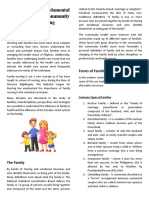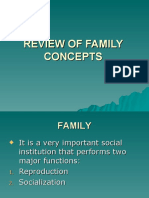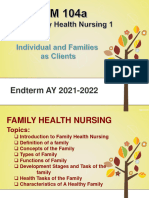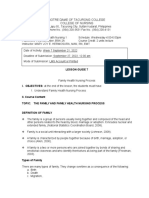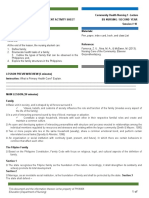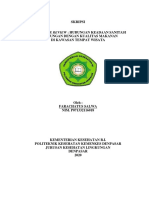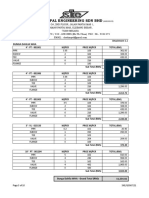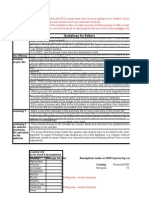0 ratings0% found this document useful (0 votes)
14 viewsCHN Notes
CHN Notes
Uploaded by
tt9zx27kmjThis document discusses the family, including its definition, types, functions, stages of development, and role in healthcare. It defines the family as a group usually living together related by blood, marriage or adoption. Family forms include the nuclear, extended, blended, single-parent, and gay/lesbian families. Families meet societal needs like procreation and socialization, and individual needs like physical and emotional support. The stages of the family life cycle are discussed, from marriage to launching adult children. The document also explores the family as a system and the nursing process used to assess family health and provide care.
Copyright:
© All Rights Reserved
Available Formats
Download as PDF, TXT or read online from Scribd
CHN Notes
CHN Notes
Uploaded by
tt9zx27kmj0 ratings0% found this document useful (0 votes)
14 views12 pagesThis document discusses the family, including its definition, types, functions, stages of development, and role in healthcare. It defines the family as a group usually living together related by blood, marriage or adoption. Family forms include the nuclear, extended, blended, single-parent, and gay/lesbian families. Families meet societal needs like procreation and socialization, and individual needs like physical and emotional support. The stages of the family life cycle are discussed, from marriage to launching adult children. The document also explores the family as a system and the nursing process used to assess family health and provide care.
Original Title
CHN NOTES
Copyright
© © All Rights Reserved
Available Formats
PDF, TXT or read online from Scribd
Share this document
Did you find this document useful?
Is this content inappropriate?
This document discusses the family, including its definition, types, functions, stages of development, and role in healthcare. It defines the family as a group usually living together related by blood, marriage or adoption. Family forms include the nuclear, extended, blended, single-parent, and gay/lesbian families. Families meet societal needs like procreation and socialization, and individual needs like physical and emotional support. The stages of the family life cycle are discussed, from marriage to launching adult children. The document also explores the family as a system and the nursing process used to assess family health and provide care.
Copyright:
© All Rights Reserved
Available Formats
Download as PDF, TXT or read online from Scribd
Download as pdf or txt
0 ratings0% found this document useful (0 votes)
14 views12 pagesCHN Notes
CHN Notes
Uploaded by
tt9zx27kmjThis document discusses the family, including its definition, types, functions, stages of development, and role in healthcare. It defines the family as a group usually living together related by blood, marriage or adoption. Family forms include the nuclear, extended, blended, single-parent, and gay/lesbian families. Families meet societal needs like procreation and socialization, and individual needs like physical and emotional support. The stages of the family life cycle are discussed, from marriage to launching adult children. The document also explores the family as a system and the nursing process used to assess family health and provide care.
Copyright:
© All Rights Reserved
Available Formats
Download as PDF, TXT or read online from Scribd
Download as pdf or txt
You are on page 1of 12
THE FAMILY relationship.
The homosexual family may or
• FAMILY- from the definition by the National may not have children.
Statistical Coordination Board (SCB, 2008) the -the Family Code of the Philippines (E.O No.
family is a group of persons usually living 209) expressly states that marriage is a special
together and composed of the head and other contract of permanent union between a man
persons related to the head by blood, and a woman entered into in accordance with
marriage, or adoption. the law for the establishment of conjugal and
• - Regardless of the definition of family family life, same-sex marriage is not legally
accepted or the form that it may take, what is acceptable.
evident is the importance of the family unit to
society. FUNCTION OF THE FAMILLY
• ( Basic needs...) • To meet the needs of the society
• Community health nursing has long viewed • To meet the needs of individual family
the family as an important unit of healthcare, members.
with awareness that he individual can be best
understood within the social context of the THE NEEDS OF SOCIETY:
family. THROUGH:
1. PROCREATION- despite the changing forms of
TYPES OF FAMILIES the family, it has remained the universally
FAMILY FORMS INCLUDE: accepted institution for reproductive function
1. NUCLEAR FAMILY- "the family of marriage, and child rearing.
parenthooa or procreation". Composed of a 2. SOCIALIZATION OF FAMILY MEMBERS-
husband, wife, and their immediate children- Socialization is the process of learning how to
natural, adopted or both. become productive members of society. For
2. DYAD FAMILY- consisting only of husband and children, family is the "first teacher"
wife- such as newly married couples and 3. STATUS PLACEMENT- Society is characterized
"empty nesters". by a hierarchy of its members into social
3. EXTENDED FAMILY- consisting of three classes.
generations, which may include married 4. ECONOMIC FUNCTION- Observes that the
siblings and their families and/or rural family is a unit of production where the
grandparents. whole family works as a team, participating in
4. BLENDED FAMILY- which results from a union farming, fishing, or cottage industries. The
where one or both spouses bring a child or urban family is more of a unit of consumption
children from a previous marriage into a new where economically productive members
living arrangement. work separately to earn salaries and wages.
5. COMPOUND FAMILY- where a man has more
than one spouse; approved by Philippine THE NEEDS OF INDIVIDUALS:
authorities. Only Muslims by virtue of THROUGH:
Presidential Decree 1. PHYSICAL MAINTENANCE- the family provides
NO. 1083, also known as the Code of MUSLiM for the survival needs of its dependent
personal laws of the Philippines (office of the members, like young children and the aged.
President, 1977). 2. WELFARE AND PROTECTION- the family
6. COHABITING FAMILY- which is commonly supports spouses or partners by providing for
described as a "live-in" arrangement between companionship and meeting affective, sexual,
an unmarried couple who are called common- and socioeconomic needs. The family is a
law spouses and their child or children from source of motivation and morale for its
such an arrangement. members.
7. SINGLE PARENT- which results from the death
of a spouse, separation, or pregnancy outside THE FAMILY AS A CLIENT
of wedlock. • Community health nursing has long viewed
-Single parenting is faced with greater risk the family as an important unit of healthcare.
associated with lesser social, emotional, and • Nursing assessment and intervention must
financial resources, which affect the general not stop with the immediate social context of
well-being of children and families. the family, but it must also consider the
8. THE GAY/LESBIAN FAMILY- is made up of broader social context of the community and
cohabiting couple of the same sex on a sexual society. (Friedman et al. 2003).
• It is important for nurses to work with c) Accommodation of new parenting and
families: grandparenting roles.
- The family is a critical source " in this
caregiver role, the family can also improve 3. Families with adolescents
individual members' health through health a. Development of increasing autonomy
promotion and wellness activities. for adolescents
-"In a family unit, any dysfunction that affects b. Midlife re-examination of marital and
one or more family members and unit as a career issues
whole" referred as "ripple effect". The nurse c. Initial shift towards concern for the
must assess each individual and the family older generation
unit.
- "Case finding" is another reason to work 4. Families as launching centers
with families. The nurse may identify a health a. Establishment of independent
problem that necessitates identifying risks for identities for parents and grown
the entire family. children
-"Improving nursing care" the nurse can b. Renegotiation of marital relationship
provide better and more holistic care by c. Readiustment of relationships to
understanding the family and its members. include in-laws and children
d. Dealing with disabilities and death of
When the family informs the nurse that they do not older generation
utilize the services of a nearby health center, the nurse
must find out the reason. FAMILY NURSING PROCESS
By improving nursing care, the family can help • ASSESSMENT
improve public health programs. • DIAGNOSIS
• PLANNING
THE FAMILY AS A SYSTEM • IMPLEMENTATION
• The GENERAL SYSTEM THEORY (Minuchin, • EVALUATION
2002; von Bertalanffy, 1968, 1972, 1974) has *RESEARCHES
been applied to the study of families. *INTERPROFESSIONAL CARE IN THE COMMUNITY
- It is a way to explain how the family as a unit
interacts with larger units outside the family FAMILY HEALTH ASSESSMENT
and with smaller units inside the family. The • Assessment of the family helps practitioners
family maybe affected by any disrupting force identify the health status of individual
acting on a system outside the family. members of the family and aspects of family
(suprasystem) composition, function and process.
The family is embedded in social systems that - The nurse can obtain information for the FHA
have an influence on health. through INTERVIEWS with one or more family
An understanding of system theory is still members, interviews of subsystems within the
important for the nurse working with families family or group interviews with more than
today. Dust and Trivette (2009) reviewed 20 two members of the family. The following
years of systems theory provides direction in critical components are: Manners,
understanding how health care providers can therapeutic questions, conversation, family
expand family capacity by changing parenting, genogram, and commendations.
and therefore changing child behaviors. - Also the nurse can obtain data through
OBSERVATION of the environment in which
STAGES AND TASKS OF THE FAMILY LIFE CYCLE the family lives, including housing, the
1. MARRIAGE: joining of families neighborhood, and the larger community.
a) Formation of identity as a couple - PHYSICAL EXAMINATION and other health
b) Inclusion of spouse in realignment of assessment techniques may be used.
relationships with extended families
c) Parenthood: making decisions • SECONDARY DATA can be derived from a
review of records like charts, health center
2. FAMILIES WITH YOUNG CHILDREN records, and/or other agency records or from
a) Integration of children into family unit communication with other health workers or
b) Adjustment of tasks: child rearing, agencies who have worked with the family.
financial and household
• In the FAMILY ASSESSMENT FORM, family is 3. Family environment- physical
differentiated from household. environment inside the family's
Ex. Domestic helpers, friends, etc. home/residence, and its neighborhood.
- Other TOOLS also exist such as the Genogram, 4. Family health and health behavior-
Family tree, and Ecomap. family's ADL, self-care, risk behaviors,
health history, current health status and
• GENOGRAM- tool that outline familv's healthcare resources.
structure. Generally, three generations family
members are included with symbols denoting • Presence of Health Threats
genealogy. - Are conditions that are conducive to disease
- In this tool the nurse use this during an early and accident, or may result to failure to
family interview, starting with a blank sheet of maintain wellness or realize health potential.
paper. a) Presence of risk factors of specific
diseases
• ECOMAP- another classic tool to denict a b) Threat of cross infection from
family's linkages to its suprasystes. communicable dse.
- Accdg. To Hartman: c) Family size beyond what family resources
"the ecomap portrays an overview of the can adequately provide.
family in their situation; it demonstrate the d) Accident hazards
flow of resources, or the lacks and e) Faulty /unhealthful nutritional/eating
deprivations. It depicts the conflict-laden habits
connections between the family and the f) Stress provoking factors\
world." g) Poor home/environmental
condition/sanitation
- Inadequate living space
• FAMILY HEALTH TREE- in this tool it provides a
- Lack of food storage facilities
mechanism for recording the family's medical
- Polluted water supply
and health history.
- Presence of breeding or resting sights of
• The nurse should point:
vectors of dses.
- Causes of death
- Improper garbage disposal
- Genetically linked diseases
- Unsanitary waste disposal
- Environmental and occupational dses.
- Improper drainage system
- Psychosocial problems
- Poor lighting and ventilation
- Infectious dses.
- Noise pollution
- Risk factors associated with the family's
- Air pollution
methods of illness prevention
h) Unsanitary food handling and
- Lifestyle related risk factors
preparation
i) Unhealthy lifestyle and personal
• FAMILY DATA ANALYSIS a thorough family habits/practices
assessment yields a large volume of data. - Alcohol drinking
- It is done by comparing findings with - smoking
accepted standards for individual family - Walking barefooted
members and for the family unit. - eating raw meat/fish
- In addition, the nurse correlates findings in - Poor personal hygiene
the different data categories and checks for - self medication
significant gaps in the information or the need - Sexual promiscuity
for more details related to finding. - engaging in dangerous sports
- Inadequate rest or sleep
• The following is a system of organizing data: - Lack of relaxation activities
1. Family structure and characteristics - the - Non use of self-protection measures
nurse ivill use graphic tools such as j) Inherent personal characteristics
genogram, family health tree and ecomap. - Poor impulse control
2. Socioeconomic characteristics- data on k) Health history
social integration, educational experiences l) Inappropriate role assumption
and literacy, work history, financial - Father not assuming his role.
resources, leisure time, and cultural m) Lack of immunization
influences. n) Family disunity
-self-oriented behavior of member/s
- Unresolved conflicts of members/s FAMILY NURSE CONTACTS
- Intolerable disagreement The family-nurse relationship is developed through
family-nurse contacts, which may take the form of a
FAMILY NURSING DIAGNOSIS clinic visit, group conference, telephone contact,
-NURSING DIAGNOSES mav be formulated at several written communication, or home visit (David et al.,
levels: as individual family members, as a family unit, 2007). The nurse uses the type of family-nurse contact
or as the family in relation to its that is most suitable to the purpose or situation at
environment/community. hand.
• Specific Diagnoses as proposed by NANDA The clinic visit takes place in a private clinic, health
- Serve as a common framework of expressing center, barangay health station, or in an ambulatory
human responses to actual and potential clinic during a community outreach activity. The major
health problems. advantage of a clinic visit is the fact that a family
An Alternative tool is the Family Coping Index member takes the initiative of visiting the professional
this tool is based on the premise that nursing health worker, usually indicating the family's readiness
action may help a family in providing for a to participate in the health care process. It also allows
health needs or resolving a health problem by the nurse to maximize resources (time, other health
promoting the family's coping capacity. care providers to whom the client can be referred as
needed, and material resources, such as supplies
9 AREAS OF ASSESSMENT OF THE FAMILY COPING and equipment). Also, because the nurse has greater
INDEX: control over the environment, distractions are
1. Physical Independence lessened (David et al., 2007).
2. Therapeutic Competence There are conditions, however, when a clinic visit
3. Knowledge of health condition presents an obvious hardship for the family, such as
4. Application of principles of personal and when the family is unable to transport the family
general hygiene member requiring nursing care. Precisely because the
5. Health care attitudes nurse is in control of the situation, the family may feel
6. Emotional competence less confident to discuss family health
7. Family living patterns concerns.
8. Physical environment A group conference, such as a conference of mothers
9. Use of community facilities in the neighborhood, provides an opportunity for
initial contact between the nurse and target families
OBJECTIVES of the community.
• WORKABLE OBJECTIVES SHOULD BE: It may take place at a health facility or in the
1. Specific- clearly articulates who is expected to community. This type of family-nurse contact is
do what. i.e., the family or a target family appropriate for developing cooperation, leadership,
member will manifest a particular behavior. self-reliance, and/or community awareness among
2. Measurable - quantifiable indications of the group members. The opportunity to share experiences
family's achievement as a result of their and practical solutions to common health concerns is
efforts toward a goal provide a concrete basis a strength of this type of family-nurse contact.
for monitoring and evaluation. However, attendance in a group conference usually
3. Attainable- realistic and in conformity. requires motivation and availability of target family
4. Relevant- appropriate for the family need or members. The nurse, therefore, may not be able to
problem. reach the families in greatest need of help through a
5. Time-bound- having a specified target time or group conference.
date. If the resources are available, the telephone (landline
or mobile/cell) provides easy access between the
ESTABLISHING GOALS AND OBJECTIVES nurse/health worker and the family. The wide reach of
mobile/ cell phone communication services in the
• GOAL - is a desired observable family response to
country provides the nurse and the family with
planned interventions in response to a mutually
opportunities to contact each other through calls or
identified family need. The goal is the end that the
short messaging service (text messaging). Encouraging
nurse and the family aim to achieve. "realistic goals"
the family to communicate with the clinic or health
• OBJECTIVES- define the desired step-by-step family
center when they feel the need for it cultivates the
responses as they work toward a goal.
family's confidence in the health agency.
They are used to measure family achievement for
monitoring and evaluation.
However, information transmitted through the *To simplify the discussion, this portion of the text is
telephone is limited. Accurate assessment of family written with feminine pronouns in reference to the
conditions usually requires face-to-face contact. nurse. It may well be that the nurse is a male.
Previsit phase
Written communication is used to give specific During the previsit phase, if possible, the nurse
information to families, such as instructions given to contacts the family, determines the family's
parents through school children. willingness for a home visit, and sets an appointment
Although there is a potential for reaching many with them. A plan for the home visit is formulated
families, being a one-way method and requiring during this phase.
literacy and interest, the nurse cannot be certain that The planning process for a home visit is essentially the
the information will reach the intended recipient. same as the planning phase of the nursing process.
For purposes of clarity, the following are specific
Home visit principles in planning for a home visit (David et al.,
A home visit is a professional, purposeful interaction 2007):
that takes place in the family's residence aimed at • Being a professional contact with the family, the
promoting, maintaining, or restoring the health of the home visit should have a purpose.
family or its members. It is a family-nurse contact Although the nurse is a guest in the family's home, the
where, instead of the family going to the nurse, the visit is not for social reasons and should be
nurse goes to the family. The nurse makes a home visit therapeutic (Maurer and Smith, 2009). A home visit
upon the family's request, as a result of case finding, may have one or more of the following purposes
in response to a referral, or to follow-up clients who (David et al., 2007):
have utilized services of a health facility such as a • To have a more accurate assessment of the family's
health center, lying-in clinic, or hospital. living conditions and adapt interventions accordingly.
• To educate the family about measures for health
A home visit has the following advantages: promotion, disease prevention, and control of health
• It allows firsthand assessment of the home problems.
situation: family dynamics, environmental • To prevent the spread of infection among family
factors affecting health, and resources within members and within the community.
the home. • To provide supplemental interventions for the sick,
• The nurse is able to seek out previously disabled, or dependent family member and, whenever
unidentified needs (David et al., 2007). possible, guide the family on how to give care in the
• It gives the nurse an opportunity to adapt future.
interventions according to family resources • To provide the family with greater access to health
(Stanhope and Lancaster, 2010). resources in the community by establishing a close
• It promotes family participation and focuses relationship with them, providing information, and
on the family as a unit (Maurer and Smith, making referrals as necessary.
2009). • Use information about the family collected from all
• Teaching family members in the home is made possible sources, such as records, other personnel
easier by the familiar environment and the and/or agency, or previous contacts with the family.
recognition of the need to learn as they are All available information is used to determine and
faced by the actual home situation (Maurer analyze the family situation.
and Smith, 2009). • The home visit plan focuses on identified family
• The personalized nature of a home visit gives needs, particularly needs recognized by the family as
the family a sense of confidence in themselves requiring urgent attention.
and in the agency (David et al., 2007). Based on information about the family, the nurse
considers what is expected of him or her, such as care
The major disadvantage relates to efficiency: the cost of a postpartum and her newborn baby or care of a
in terms of time and effort. Also, because the nurse is sick or disabled family member.
unable to control the environment, there are more • Continuing care for a client who needs it will be
distractions in the home. The nurse's safety may also provided by the client and/or responsible family
be a concern (Maurer and Smith, 2009). members. Therefore, the client and the family should
actively participate in planning for continuing care.
Phases of a home visit* • It is seldom that the nurse has up-to-date, accurate,
The home visit has three phases: previsit, in-home, and all necessary information about the client and the
and postvisit phases (adapted from Maurer and Smith, family. The plan should be practical and adaptable,
2009 and Stanhope and Lancaster, 2010). considering the actual family situation and the
resources available to the nurse and the family.
Flexibility is important in working with families If the family needs further services that the nurse and
because the nurse will not know the family's priority his or her agency cannot provide, the nurse explores
needs until the home visit. with the family other community facilities that the
Before leaving the health facility, the nurse should family can be referred to.
check the contents of the nursing bag and other Since the nurse performs assessment and physical
articles she needs in order to carry out the home visit care of clients, it is important that he or she observes
efficiently and safely. It is important that the nurse aseptic practices such as hand washing before and
comply with practices and policies for personnel after touching family members and proper disposal of
safety, such as informing the other personnel of his or soiled materials and body secretions. Coupled with
her itinerary. The "buddy system" is suggested for explanations, this is an opportunity for the nurse to
nursing students and personnel new to the service. teach the family by visual demonstration practical
The buddy may be another student, health methods of preventing the spread of infection.
professional, or a member of the community such as a Some of the objectives of the home visit may be
barangay health worker. The nurse should inform the evaluated towards the end of the visit, while some
family to be visited of this practice, if possible, before objectives require further family-nurse contacts. As
the visit. much as possible, the nurse evaluates with the family
In the absence of a buddy, however, it is important what they have accomplished during the visit.
that the nurse makes a spot map of the house for Termination: This consists of summarizing with the
visiting and identify with other members of the health family the events during the home visit and setting a
team of the time that one is expected to be back to subsequent home visit or another form of family-
the health care facility. This will assist the colleagues nurse contact such as a clinic visit. If necessary, the
in determining whereabouts of the nurse in case she is nurse may also use this time to record findings, such
not back as indicated. as vital signs of family members and body weight.
Postvisit phase
In-home phase The postvisit phase takes place when the nurse has
This phase begins as the nurse seeks permission to returned to the health facility.
enter and lasts until he or she leaves the family's This involves documentation of the visit during which
home. The in-home phase consists of initiation, the nurse records events that transpired during the
implementation, and termination. visit, including personal observations and feelings of
Initiation: It is customary to knock or ring the doorbell the nurse about the visit. This will help the other
and, at the same time, in a reasonably loud but members of the health team to understand the family,
nonthreatening voice say, providing for a more effective intervention.
"Tao po. Si Jenny po ito, nurse sa health center, or a If appropriate, a referral may be made. If a subsequent
similar greeting in the vernacular or some other visit has been set, planning for the next visit is done at
language common to the nurse and the family. this time.
On entering the home, the nurse acknowledges the
family members) with a greeting and introduces The Nursing Bag
himself or herself and the agency he or she The nursing bag, frequently called the PHN bag, is a
represents. At this point, the nurse observes the tool used by the nurse during home and community
environment for his or herown safety and sits as the visits to be able to provide care safely and efficiently.
family directs him or her to sit (Maurer and Smith, The contents of the bag depend upon agency policies
2009). To establish rapport, the nurse initiates a short and the type of services expected of the nurse while
social conversation. He or she then states the purpose he or she is in the community or in the client's home.
of the visit and the source of information. Besides its obvious function of providing a receptacle
Implementation: Implementation involves the for items needed for nursing care, which would
application of the nursing process-assessment, usually not be available in the home, the bag serves as
provision of direct nursing care as needed, and a reminder of the need for hand hygiene and other
evaluation. measures to prevent the spread of infection. It also
Assessment consists of techniques such as interview, supports the idea that the nurse must be prepared for
physical examination, and simple diagnostic a variety of situations while in the field.
examinations that can be done at home, like capillary The nursing bag usually has the following
blood glucose determination. It includes observation
of family dynamics and the family's physical contents:
environment. The Family Assessment Form is used as • Articles for infection control: soap in a
a guide for this purpose. covered soap dish and linen or disposable
Physical care, health teachings, and counseling are paper towels for hand washing, apron, bottles
provided to the family as needed or according to plan. of antiseptics, and hand sanitizer.
• Articles for assessment of family members: • Bag technique may be performed in different
body thermometers), measuring tape, ways. There may be variations in using the
newborn weighing scale, portable diagnostic bag technique because of agency policies and
aids such as glucometer (if available), or items the home situation. However, principles of
for Benedict's test (Benedict's solution, asepsis are of the essence and should be
medicine dropper, test tube, test-tube holder, practiced at all times.
alcohol lamp). Note that the stethoscope and
sphygmomanometer are carried separately. For infection control, the following activities
• Articles for nursing care should be practiced during home visits and as part
o Sterile items: dressings, cotton balls, of bag technique:
cotton tip applicators, syringes (2 and • Remember to proceed from "clean" to
5 ml) with needles, surgical gloves, "contaminated." For example, provide nursing
cord clamp, one pair surgical scissors, care first to the newborn, then the
sterile pack with kidney basin, two postpartum. If the nurse schedules several
pairs of forceps (straight and curved. home visits within the day, the sequence
o Clean articles: adhesive tape, should be the family with a postpartum and
bandage scissOrs. newborn first, then the family with a
o Pieces of paper: for lining the soap communicable case.
dish if the home sink is used and for • The bag and its contents should be well
lining the bag (a washable rubber protected from contact with any article in the
protector may also be used for this patient's home. Consider the bag and its
purpose), and folded paper to be content clean or sterile, while articles that
used as waste receptacle if needed. belong to the patients as dirty and
The following are the general principles in the contaminated.
use of the nursing bag (bag technique): • Line the table/flat surface with paper/
• Bag technique helps the nurse in infection washable protector on which the bag and all
control. The proper use of the bag allows the of the articles to be used are placed.
practice of medical aseptic technique during • Wash your hands before and after physical
the home visit where the family members and assessment and physical care of each family
the articles in the home are considered member.
potential sources of infection. The nurse • Bring out only the articles needed for the care
protects himself or herself and the nursing of the family. Those that will not be used
bag and its contents from contamination. The should remain in the bag. This practice is
nurse uses the bag technique as a live facilitated when the contents of the bag are
demonstration to the family of practical arranged according to the nurse's convenience
methods of infection control, such as hand to avoid confusion and promote efficiency.
washing, one of the most important steps that • Do not put any of the family's articles on your
anyone can take to avoid the spread of paper lining/washable protector,
infection (CDC, 2012). • Whenever possible and as necessary, wash
• Bag technique allows the nurse to give care your articles before putting them back into
efficiently. It saves time and effort by ensuring the bag. If this is not possible, wrap them
that the articles needed for nursing care are properly to prevent contaminating the bag
available. It is important for the nurse to check and its contents.
the contents of the bag for completeness and • After using an article such as an apron or
for proper functioning (as needed) before washable protector, confine the contaminated
leaving the health facility for a home visit. The surface by folding the contaminated side
traditional nursing bag is constructed to allow inward.
the efficient arrangement of its contents. • Wash the inner cloth lining of the bag as
Articles piled on top of each other must be necessary.
arranged according to use, with the article to
be used first placed on top. For example,
Family Nursing Care Plan
articles for hand washing should be placed on
top of the center of the bag. FIRST LEVEL ASSESSMENT
• Bag technique should not take away the •The process of determining existing and potential
nurse's focus on the patient and the family. It health conditions or problems of the family. These
is simply a tool in providing care. health conditions are categorized as:
I. Presence of Wellness Condition •Inadequate food intake both in quality and quantity
• Stated as “Potential” or “Readiness”; a clinical •Excessive intake of certain nutrients
or nursing judgment about a client in •Faulty eating habits
transition from a specific level of wellness or •Ineffective breastfeeding
capability to a higher level. Wellness potential •Faulty feeding techniques
is a nursing judgment on wellness state or
condition based on client’s performance, F. Stress Provoking Factors.
current competencies, or performance, •Strained marital relationship
clinical data or explicit expression of desire to •Strained parent-sibling relationship
achieve a higher level of state or function in a •Interpersonal conflicts between family members
specific area on health promotion and •Care-giving burden
maintenance.
•G. Poor Home/Environmental Condition/Sanitation
A. Potential for Enhanced Capability for: •Inadequate living space
• Healthy lifestyle-e.g., nutrition/diet, •Lack of food storage facilities
exercise/activity •Polluted water supply
• Healthy maintenance/health management •Presence of breeding or resting sights of vectors of
• Parenting diseases
• Breastfeeding •Improper garbage/refuse disposal
•Unsanitary waste disposal
• Spiritual well-being-process of client’s
•Improper drainage system
developing/unfolding of mystery through
•Poor lightning and ventilation
harmonious interconnectedness that comes
•Noise pollution
from inner strength/sacred source/God
•Air pollution
• Others. Specify.
B. Readiness for Enhanced Capability for:
H. Unsanitary Food Handling and Preparation
• Healthy lifestyle
• Health maintenance/health management
I. Unhealthy Lifestyle and Personal Habits/Practices.
• Parenting
Specify.
• Breastfeeding •Alcohol drinking
• Spiritual well-being •Cigarette/tobacco smoking
• Others. Specify. •Walking barefooted or inadequate footwear
•Eating raw meat or fish
II. Presence of Health Threats •Poor personal hygiene
•Are conditions that are conducive to disease and •Self medication/substance abuse
accident or may result to failure to maintain wellness •Sexual promiscuity
or realize health potential. •Engaging in dangerous sports
•Inadequate rest or sleep
A.Presence of risk factors of specific diseases (e.g., •Lack of /inadequate exercise/physical activity
lifestyle diseases, metabolic syndrome, smoking) •Lack of/relaxation activities
•Nonuse of self-protection measures (e.g., nonuse of
B. Threat of cross infection from communicable bed nets in malaria and filariasis endemic areas).
disease case
J. Inherent Personal Characteristics
C. Family size beyond what family resources can •e.g., poor impulse control
adequately provide
K. Health History, which may Participate/Induce the
D. Accident hazards specify. Occurrence of Health Deficit
•Broken chairs •e.g., previous history of difficult labor.
•Pointed /sharp objects, poisons and medicines
improperly kept L. Inappropriate Role Assumption
•Fire hazards •e.g., child assuming mother’s role, father not
•Fall hazards assuming his role.
•Others specify.
M. Lack of Immunization/Inadequate Immunization
E. Faulty/unhealthful nutritional/eating habits or Status Especially of Children
feeding techniques/practices. Specify.
N. Family Disunity • Economic/cost implications
•Self-oriented behavior of member(s) • Physical consequences
•Unresolved conflicts of member(s) • Emotional/psychological issues/concerns
•Intolerable disagreement C. Attitude/Philosophy in life, which hinders
recognition/acceptance of a problem
III. Presence of health deficits
•These are instances of failure in health maintenance. II. Inability to make decisions with respect to
taking appropriate health action due to:
A. Illness states, regardless of whether it is diagnosed A. Failure to comprehend the nature/magnitude of
or undiagnosed by medical practitioner. the problem/condition
B. Failure to thrive/develop according to normal rate B. Low salience of the problem/condition
C. Disability C. Feeling of confusion, helplessness and/or
•Whether congenital or arising from illness; resignation brought about by perceive
transient/temporary (e.g., aphasia or temporary magnitude/severity of the situation or problem,
paralysis after a CVA) or permanent (e.g., leg i.e., failure to break down problems into manageable
amputation, blindness from measles, lameness from units of attack.
polio)
D. Lack of/inadequate knowledge/insight as to
alternative courses of action open to them
IV. Presence of stress points/ foreseeable crisis
situations E. Inability to decide which action to take from
•Are anticipated periods of unusual demand on the among a list of alternatives
individual or family in terms of adjustment/family
resources. F. Conflicting opinions among family
members/significant others regarding action to take.
•A. Marriage
•B. Pregnancy, labor, puerperium G. Lack of/inadequate knowledge of community
•C. Parenthood resources for care
•D. Additional member-e.g., newborn, lodger
•E. Abortion H. Fear of consequences of action, specifically:
•F. Entrance at school • Social consequences
•G. Adolescence • Economic consequences
•H. Divorce or separation • Physical consequences
•I. Menopause • Emotional/psychological consequences
•J. Loss of job I. Negative attitude towards the health condition or
•K. Hospitalization of a family member problem-by negative attitude is meant one that
•L. Death of a member interferes with rational decision-making.
•M. Resettlement in a new community J. In accessibility of appropriate resources for care,
•N. Illegitimacy specifically:
• Physical Inaccessibility
Second Level Assessment • Costs constraints or economic/financial
•Second level assessment identifies the nature or type inaccessibility
of nursing problems the family experiences in the K. Lack of trust/confidence in the health
performance of their health tasks with respect to a personnel/agency
certain health condition or health problem. L. Misconceptions or erroneous information about
proposed course(s) of action
I. Inability to recognize the presence of the
condition or problem due to:
A. Lack of or inadequate knowledge III. Inability to provide adequate nursing care to
B. Denial about its existence or severity because of the sick, disabled, dependent or vulnerable/at risk
fear of consequences of diagnosis of problem, member of the family due to:
specifically: A. Lack of/inadequate knowledge about the
• Social-stigma, loss of respect of disease/health condition (nature, severity,
peer/significant others complications, prognosis and management)
D. Lack of/inadequate knowledge of preventive
B. Lack of/inadequate knowledge about child measures
development and care
E. Lack of skill in carrying out measures to improve
C. Lack of/inadequate knowledge of the nature or home environment
extent of nursing care needed
D. Lack of the necessary facilities, equipment and
supplies of care
E. Lack of/inadequate knowledge or skill in carrying
out the necessary intervention or
treatment/procedure of care (i.e. complex
therapeutic regimen or healthy lifestyle program).
F. Inadequate family resources of care specifically:
F. Ineffective communication pattern within the
• Absence of responsible member
family
• Financial constraints
• Limitation of luck/lack of physical resources G. Lack of supportive relationship among family
members
G. Significant persons unexpressed feelings (e.g.,
hostility/anger, guilt, fear/anxiety, despair, rejection) H. Negative attitudes/philosophy in life which is not
which his/her capacities to provide care. conducive to health maintenance and personal
development
H. Philosophy in life which negates/hinder caring for
the sick, disabled, dependent, vulnerable/at risk
member
I. Member’s preoccupation with on
concerns/interests
J. Prolonged disease or disabilities, which exhaust
supportive capacity of family members.
K. Altered role performance, specify.
• Role denials or ambivalence
• Role strain
• Role dissatisfaction
• Role conflict
• Role confusion
• Role overload
IV. Inability to provide a home environment
conducive to health maintenance and personal
development due to: I. Lack of adequate competencies in relating to each
other for mutual growth and maturation
A. Inadequate family resources specifically:
Example: reduced ability to meet the physical and
• Financial constraints/limited financial
psychological needs of other members as a result of
resources
family’s preoccupation with current problem or
• Limited physical resources-e.i. lack of space to
condition.
construct facility
B. Failure to see benefits (specifically long term ones)
of investments in home environment improvement
V. Failure to utilize community resources for health
care due to:
C. Lack of/inadequate knowledge of importance of
hygiene and sanitation A. Lack of/inadequate knowledge of community
resources for health care
B. Failure to perceive the benefits of health
care/services
C. Lack of trust/confidence in the agency/personnel
D. Previous unpleasant experience with health
worker
E. Fear of consequences of action (preventive,
diagnostic, therapeutic, rehabilitative) specifically :
• Physical/psychological consequences
• Financial consequences
• Social consequences
F. Unavailability of required care/services
G. Inaccessibility of required services due to:
• Cost constraints
• Physical inaccessibility
H. Lack of or inadequate family resources, specifically
Manpower resources, e.g., babysitter
Financial resources, cost of medicines prescribe
I. Feeling of alienation to/lack of support from the
community
e.g., stigma due to mental illness, AIDS, etc.
J. Negative attitude/ philosophy in life which hinders
effective/maximum utilization of community
resources for health care
You might also like
- Community Health NursingDocument17 pagesCommunity Health NursingSpinel Cheyne Nirvana100% (3)
- Module 2 The FamilyDocument26 pagesModule 2 The FamilyFrancine De Los Reyes100% (1)
- 7.UDCPR Sanctioned.... 111 PDFDocument397 pages7.UDCPR Sanctioned.... 111 PDFRajesh Ket100% (1)
- The Family, The Fundamental Unit of ServiceDocument5 pagesThe Family, The Fundamental Unit of ServiceXandra BasnilloNo ratings yet
- Community Health NursingDocument6 pagesCommunity Health NursingKimberly DerigeNo ratings yet
- Procreation - Socialization of The Family MemberDocument3 pagesProcreation - Socialization of The Family Memberkazelle GentallanNo ratings yet
- The FamilyDocument39 pagesThe FamilyAlexious Marie Callueng100% (2)
- Community Health NursingDocument11 pagesCommunity Health NursingIligan, Jamaicah100% (1)
- Module 6 With Activities - NCM 104Document14 pagesModule 6 With Activities - NCM 104Jann ericka JaoNo ratings yet
- The FamilyDocument43 pagesThe FamilyShermaigne Ananayo BuyaNo ratings yet
- Family and CommunityDocument46 pagesFamily and CommunityCez0408No ratings yet
- CHN - Cu4Document3 pagesCHN - Cu4Thy SantillanNo ratings yet
- Family Health NursingDocument17 pagesFamily Health NursingMIKAELLA BALUNANNo ratings yet
- CHN Chapter 6 FamilyDocument5 pagesCHN Chapter 6 FamilyPaula Thea ColeenNo ratings yet
- CHN NotesDocument38 pagesCHN NotesMacchi MagsNo ratings yet
- The FamilyDocument17 pagesThe FamilyJamaica NacenoNo ratings yet
- CHN211 Week 4 WORD - Family Health NursingDocument8 pagesCHN211 Week 4 WORD - Family Health NursingCay ObejeroNo ratings yet
- Module 3 Family Health NursingDocument44 pagesModule 3 Family Health Nursing17melrosefloresNo ratings yet
- Chapter 6 Family Health NursingDocument10 pagesChapter 6 Family Health Nursingprincessbenito13No ratings yet
- NCM 104 Lecture Chapter 3-Individual Family As A ClientDocument50 pagesNCM 104 Lecture Chapter 3-Individual Family As A ClientWilma Nierva Beralde100% (1)
- NCM 104 MT ReviewerDocument5 pagesNCM 104 MT Reviewerrenzangeloponciano22No ratings yet
- Output 3 - Family Health NursingDocument9 pagesOutput 3 - Family Health Nursingromelyn100% (1)
- CHN1 - Lesson Guide 7Document12 pagesCHN1 - Lesson Guide 7Yahra DatangNo ratings yet
- CHN Files Complete 1Document316 pagesCHN Files Complete 1ASTR4 BABYNo ratings yet
- Nursing Care of The Community: Edna R. Javier RN Man Faculty, College of NursingDocument27 pagesNursing Care of The Community: Edna R. Javier RN Man Faculty, College of Nursingrnrmmanphd100% (1)
- The Childbearing and Chilbearing Family 3Document14 pagesThe Childbearing and Chilbearing Family 3milescoducoNo ratings yet
- Family Health NursingDocument53 pagesFamily Health NursingCharina AubreyNo ratings yet
- CHN MidtermsDocument5 pagesCHN MidtermspaderamosNo ratings yet
- CHN I (Lecture) Hand-Outs WK 2Document14 pagesCHN I (Lecture) Hand-Outs WK 2Gabbi CadieuxNo ratings yet
- Module 4: The Family (2 Hours)Document17 pagesModule 4: The Family (2 Hours)camille nina jane navarroNo ratings yet
- CHN FamilyDocument4 pagesCHN FamilyHarel CasipongNo ratings yet
- FamilyDocument10 pagesFamilyMacy DysancoNo ratings yet
- CONCEPT OF FAMILY-Family Nursing ProcessDocument9 pagesCONCEPT OF FAMILY-Family Nursing ProcessJunry PilapilNo ratings yet
- Family Health Nursing ProcessDocument9 pagesFamily Health Nursing ProcessLuis WashingtonNo ratings yet
- The Family As The Basic Unit of SocietyDocument6 pagesThe Family As The Basic Unit of SocietyYza Belle RamoNo ratings yet
- Output 3 - Family Health NursingDocument5 pagesOutput 3 - Family Health NursingromelynNo ratings yet
- CHN Family TRANSESDocument1 pageCHN Family TRANSESQueen RiquezNo ratings yet
- Family and Family HealthDocument10 pagesFamily and Family HealthLea Jane ArmeñaNo ratings yet
- Pediatric ReviewerDocument3 pagesPediatric ReviewereannnicholleNo ratings yet
- Nursing Care of The Community CHP 6 3Document34 pagesNursing Care of The Community CHP 6 3gallardo.bettinarose.iNo ratings yet
- Primary Health Care 1: Health Care Process As Applied To The Family 1Document59 pagesPrimary Health Care 1: Health Care Process As Applied To The Family 1juanamay30gmailcomNo ratings yet
- Maternal Notes 1Document7 pagesMaternal Notes 1ubrieubrieNo ratings yet
- NCM 211 Lect - Family Basic Unit of ServiceDocument9 pagesNCM 211 Lect - Family Basic Unit of ServiceLYRIZZA LEA BHEA DESIATANo ratings yet
- The Family Definition and Concepts of FamilyDocument6 pagesThe Family Definition and Concepts of FamilyMikhaela Andree MarianoNo ratings yet
- UnvghjnnntitledDocument10 pagesUnvghjnnntitledkeerthi sivayanamaNo ratings yet
- Chapter 24 Promoting Family HealthDocument24 pagesChapter 24 Promoting Family HealthLeviana SyNo ratings yet
- Family Health NursingDocument10 pagesFamily Health NursingKarl Kiw-is0% (1)
- Dynamics of FamilyDocument57 pagesDynamics of Familyjeranyl castilloNo ratings yet
- Unit IvDocument13 pagesUnit IvShane PangilinanNo ratings yet
- Family - CHN1Document34 pagesFamily - CHN1Nathaniel PulidoNo ratings yet
- NCM 104 CHNDocument23 pagesNCM 104 CHNAljun EstipularNo ratings yet
- FNCP NotesDocument13 pagesFNCP NotesAmiel Francisco ReyesNo ratings yet
- Unit - V Spiritual Needs of Children and FamiliesDocument10 pagesUnit - V Spiritual Needs of Children and FamiliesPeng MyouiNo ratings yet
- Definition of FamilyDocument6 pagesDefinition of FamilyKeana DacayanaNo ratings yet
- Community Health NursingDocument5 pagesCommunity Health Nursingalibayajenny2No ratings yet
- The Family PDFDocument40 pagesThe Family PDFsfdNo ratings yet
- FamilyDocument10 pagesFamilyAmal A HassanNo ratings yet
- Reviewer - Chn - MidtermDocument20 pagesReviewer - Chn - Midtermangelrosefesalaza255No ratings yet
- CHN1 Lec Session #10 SASDocument11 pagesCHN1 Lec Session #10 SASFrances PaqueoNo ratings yet
- Marriage and Family Counseling - A Manual for Ministers, Doctors, Lawyers, Teachers, Social Workers, And Others Engaged in Counseling ServiceFrom EverandMarriage and Family Counseling - A Manual for Ministers, Doctors, Lawyers, Teachers, Social Workers, And Others Engaged in Counseling ServiceNo ratings yet
- SwachhBharat - Du VacDocument3 pagesSwachhBharat - Du VacAsmi SinglaNo ratings yet
- Coca Cola The Water Stewardship and Replanish Report1 2012Document80 pagesCoca Cola The Water Stewardship and Replanish Report1 2012CSRmedia.ro NetworkNo ratings yet
- Group 1 - Ambuja Cements CSR - Final ReportDocument26 pagesGroup 1 - Ambuja Cements CSR - Final ReportNikhil UpadhyaNo ratings yet
- Kyamusisi Socio-Economic Report 122Document9 pagesKyamusisi Socio-Economic Report 122Batambuze SalimNo ratings yet
- Reviewer Ra 1364sbn 2112 PD 856 Code Long BondDocument9 pagesReviewer Ra 1364sbn 2112 PD 856 Code Long BondDar LeneNo ratings yet
- Presentation TCW 2Document9 pagesPresentation TCW 2Jam SolisNo ratings yet
- Water Conservation in IndiaDocument5 pagesWater Conservation in IndiaPONTIOUS TALLY100% (1)
- Literature Review: Hubungan Keadaan Sanitasi: SkripsiDocument17 pagesLiterature Review: Hubungan Keadaan Sanitasi: SkripsiLiskayanti PkyNo ratings yet
- Elevation-B Elevation - A Elevation - D Elevation - C: S S S S SDocument1 pageElevation-B Elevation - A Elevation - D Elevation - C: S S S S SghansaNo ratings yet
- Lesson Plan in Bread and Pastry Production Ncii I. ObjectivesDocument2 pagesLesson Plan in Bread and Pastry Production Ncii I. ObjectivesDezzelyn Balleta100% (3)
- Plumbing Definition of Terms Part 2Document73 pagesPlumbing Definition of Terms Part 2kristina aquinoNo ratings yet
- D9 1 Assessment ChecklistDocument5 pagesD9 1 Assessment ChecklistVu Hung NguyenNo ratings yet
- A Guide To Septage Transfer StationsDocument26 pagesA Guide To Septage Transfer StationsrupakhasanNo ratings yet
- Unit 1Document15 pagesUnit 1annusingh4561885No ratings yet
- Sri Kimpal Engineering SDN BHD: Bunga Dahlia WhaDocument8 pagesSri Kimpal Engineering SDN BHD: Bunga Dahlia WhaAhmad Aliyan Alif Bin IsmailNo ratings yet
- Rhu Profiling Tools 2018 R8Document29 pagesRhu Profiling Tools 2018 R8Donna Tabique CandolitaNo ratings yet
- Ujwal Hyggiene A4 Leaflet - 002Document2 pagesUjwal Hyggiene A4 Leaflet - 002Mohammad Shafi ShaikhNo ratings yet
- Eng PDFDocument220 pagesEng PDFyunNo ratings yet
- Site Clean Up and Decommissioning SOPDocument5 pagesSite Clean Up and Decommissioning SOPash amenNo ratings yet
- WasaDocument1 pageWasashorifmrh0% (1)
- Design Standards Volume 3 04 DrainageDocument61 pagesDesign Standards Volume 3 04 DrainageLeonardo TejedorNo ratings yet
- Page 11Document1 pagePage 11Darren ValienteNo ratings yet
- Water and Sanitation in KABWE REPORTDocument15 pagesWater and Sanitation in KABWE REPORTEvangelist Kabaso Sydney50% (2)
- Waste Water Engineering Questions and Answers - Systems of PlumbingDocument3 pagesWaste Water Engineering Questions and Answers - Systems of PlumbingNick GeneseNo ratings yet
- Detail I Detail Ii: Skala 1: 2 Skala 1: 2Document1 pageDetail I Detail Ii: Skala 1: 2 Skala 1: 2hari alfandiNo ratings yet
- Gtz2010 en Worldwide Ecosan Project List (Version 1)Document1,129 pagesGtz2010 en Worldwide Ecosan Project List (Version 1)Jeff WhiteNo ratings yet
- Water Supply Eng'gDocument196 pagesWater Supply Eng'gFiraol OromoNo ratings yet
- What Is The Difference Between A Gully Trap and A P Trap - Quora1Document3 pagesWhat Is The Difference Between A Gully Trap and A P Trap - Quora1IeeeChannaNo ratings yet
- Ev STBMDocument16 pagesEv STBMFAZANo ratings yet



